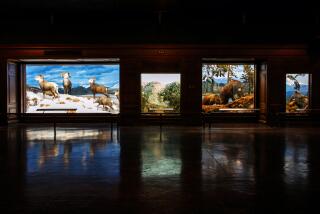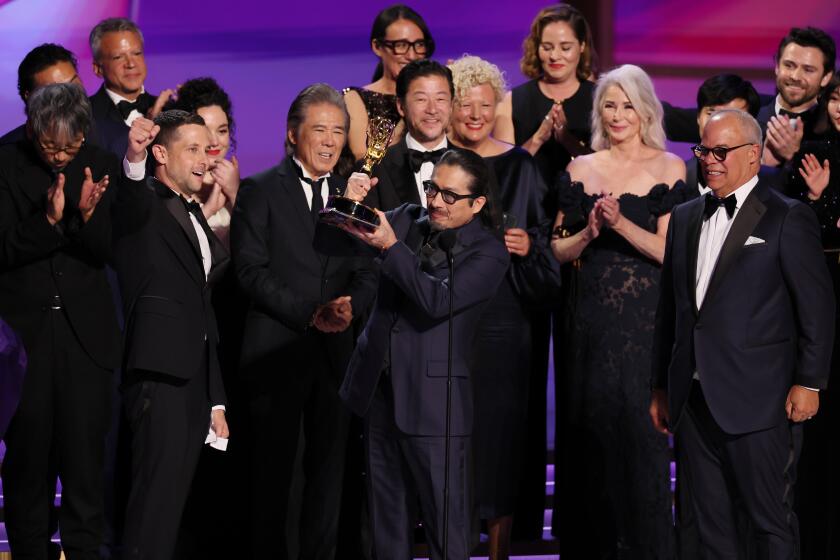Dinosaur Hall holds something big

There is nothing juvenile about the three Tyrannosaurus rex skeletons at the heart of the Natural History Museum’s new Dinosaur Hall, crouching with their great heads and menacing teeth hovering just above an unlucky duck-billed Edmontosaurus skeleton — yet one could say they represent the next generation of museum dinosaurs.
They are the youngest T.rex fossils ever found. The oldest, nicknamed “Thomas,” age 17, is at the peak of puberty, already 34 feet tall and 7,000 pounds at full body weight. The youngest is a 2-year-old toddler, but at 11 feet tall, he’s no pushover, and neither is the 13-year-old adolescent at 20 feet and 4,000 pounds.
FOR THE RECORD:
Dinosaur Hall: A July 3 graphic about the Natural History Museum’s new Dinosaur Hall incorrectly credited information to the National History Museum. It should have said the Natural History Museum of Los Angeles County. Also, a caption under a photo of a Tyrannosaurus skeleton misidentified the fossil as Thomas. It was another Tyrannosaurus. —
The trio are the centerpiece of the museum’s newly renovated 14,000-square-foot hall, which will be open to the public July 16. The permanent exhibition is twice the size of its previous dinosaur galleries and boasts the world’s only Tyrannosaurus rex growth series.
The exhibition is an ambitious project by the Dinosaur Institute, a part of the museum that has been collecting and researching for the exhibit since 2005. With its opening, the museum’s $135-million renovation is about halfway to completion. Three more permanent exhibitions are expected to be erected by 2013 as well as the finishing touches to the Otis Booth Pavilion, a three-story museum entrance that will feature a 63-feet long, 7,000-pound fin whale specimen.
Unlike the stately erect dinosaur skeletons of many exhibits, the three stars of the museum’s hall are caught in a deadly — and ravenous — Cretaceous moment. In this exhibit, dinosaurs are not just skeletons. They were once-living creatures, yet still a mystery to scientists who have just the ancient fossils as proof of their existence. Here, visitors are invited to be more than spectators; they are taught to observe these specimens with a scientific perspective: the “how” of discovering and learning about dinosaurs.
That is one way that Luis Chiappe, Dinosaur Institute director and curator of the new exhibit, hopes to distinguish it from other well-known dinosaur destinations — the Chicago’s Field Museum, for example, or the American Museum of Natural History in New York.
“It’s a take that has not been done before,” says Chiappe. “We’re really looking at the main mysteries or questions around the dinosaurs, and we are explaining to the visitors how we as scientists are tackling the questions.”
Lowell Dingus, research associate at the American Museum of Natural History (who also directed the renovation of its Fossil Hall), said the biggest challenge of every museum is finding ways to play to their strengths. The New York dinosaur hall, for example, focuses on the evolutionary tree of vertebrates to show how dinosaurs are related to other animals like crocodiles and birds.
“I think it’s great that every exhibit is so different because just think of how boring it will be if every museum had the same exhibit,” Dingus said. “Museums can provide a greater variety of scientific resources and opportunities for the public when we build it in different ways, depending on the kinds of specimens and research that particular institute has focused on. [The Natural History Museum] is a unique educational resource both for L.A. and the rest of the world.”
Many items on display are never-before-seen fossils found and conserved by the Dinosaur Institute in the last decade.
That is critical, Chiappe said, because contemporary technology for conservation is different from that of 100 years ago, and specimens are better preserved now than ever before (according to Chiappe, the T.rex specimens in this exhibit are among the top 10 most well-preserved in the world).
It also adds to the dynamic that the discovery of dinosaurs is still an ongoing investigation.
“The people who are discovering these [specimens] are living in your lifetime,” said Jane Pisano, president and director of the Natural History Museum. “We really aim to be the dinosaur hub in the West Coast.”
In fact, Chiappe was responsible for leading much of the field work that uncovered the bones and fossils in the new exhibit, such as the T.rex trio. Chiappe said that these fossils were a breakthrough discovery because most of the other T.rex found were full grown, and no other juvenile T.rex fossils are as complete as these.
“We had no idea when we were first called on site to Montana [where the fossils were found],” Chiappe said. “This provides an interesting link in the life history of a T.rex.”
Like the dynamic postures of the T.rex fossils, the exhibit is designed to enliven what may otherwise be static, dry information to visitors who may not be particularly interested in science.
“We want to find ways to demystify the material for everyone,” said Pisano. “Many visitors don’t know much about science, but they don’t want it to be dumbed down, either. This exhibit is an interesting challenge of making [the discovery of dinosaurs] relatable and accessible for everyone, from people who didn’t graduate from high school to people with PhD’s.”
The exhibit is essentially divided into four main thematic questions: “What are dinosaurs?” “What was the world of dinosaurs like?” “How did they live, grow and behave?” and “What happened to the dinosaurs?”
Some of the answers to these questions are surprising (such as whether dinosaurs are truly extinct), while most of them raise even more questions and provide few answers.
“We want to make sure that throughout the exhibit, when we are ignorant about a subject, we say so,” Chiappe said. “It’s a way of conveying that there is a lot to be found out there and that there is plenty of room for discovery, to inspire a new generation of scientists and kids who come in here dreaming about discoveries. They may one day provide the clues to the questions that we have no answers at the moment.”
The exhibit is divided into two conjoined galleries. Floor-to-ceiling central windows provide plenty of natural light and large-scale murals of dinosaurs roaming in their natural habitats create the illusion of wider space.
Vertical space is used by installing second-level displays and suspending giant specimens of mosasaurs (extinct marine predators found in California) from the ceiling. Visitors can get closer to these specimens than ever before, and really study the textures of the fossils from all points of view.
The depth and scope of the information packed into the limited area can be overwhelming, but the design of the exhibit tries to keep a good balance of light and heavy subjects, Pisano said.
In addition to field notes, there are simple interactive games and do-it-yourself lab excavations, an entire wall of fossils showcasing 100 specimens (such as teeth, eggs, footprints and even fossilized dinosaur droppings) and colorful, eye-pleasing mural illustrations.
But for those who really want to delve deeper into the material, the exhibit provides multilayered details for each fossil and artifacts as well.
For example, visitors can view images of the fossils at all angles with a zoom-and-rotate option on a touch-screen computer, and choose to read all the field notes and encyclopedic texts about the specimen such as its minerals and tissues.
Other than the T.rex youngsters, the exhibit also showcases about 20 major mounts of specimens such as a 25-foot-long Triceratops, a 68-feet-long Mamenchisaurus (the largest specimen on view in this exhibit), and the jagged-spined stegosaurus.
“One-third of [these mounted specimens] are new,” Chiappe said. “All of them are either never displayed before, or have been rearticulated. There is not a single mount that is in the same pose or the same way that used to be in our previous dinosaur hall.”
Pisano said that the poses were created after hours of careful scientific analysis rather than whimsical imagination. The Natural History Museum brought in Phil Fraley Productions (a company that also worked for Chicago’s Field Museum) and Ontario’s Research Casting International to remount the dinosaurs in a way that would reflect their behavior in a wild habitat.
“The designers of the mounts looked at these specimens in many different point of views to create the postures and the uneven bases,” said Pisano. “There was a lot of thought and work behind every mount.”
The armored stegosaurus, for example, is shown fighting off the top predator Allosaurus, based on the wounds made by stegosaurus spikes on Allosaurus fossils.
Even with modern technology, the fossils and bones can tell only so much.
But perhaps no dinosaur exhibit can ever be complete, because the moment it is, it will lose its mythical allure. After all, the captivating quality of dinosaurs seems to come from the very fact that so little is known about them.
And hence the magic of dinosaurs lives on.
More to Read
The biggest entertainment stories
Get our big stories about Hollywood, film, television, music, arts, culture and more right in your inbox as soon as they publish.
You may occasionally receive promotional content from the Los Angeles Times.










